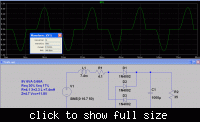- Joined
- Apr 1, 2011
- Messages
- 15,166
- Helped
- 2,898
- Reputation
- 5,808
- Reaction score
- 2,978
- Trophy points
- 1,393
- Location
- Minneapolis, Minnesota, USA
- Activity points
- 113,591
To calculate RMS involves finding the area under a curve, then leveling it out evenly across a cycle, to arrive at the equivalent level if it were constant.
The green plot shows current coming from the transformer.
So with a little measuring, I find the area under a green burst can be spread out (over a timeframe of 8.3 milliseconds), so that the equivalent current is no more than 0.3 A on the scale at the right.
I'm ignoring the initial surge at the beginning of the time graph. That burst alone might have an RMS value of 584mA, but it's not what we'd call a running value.
The green plot shows current coming from the transformer.
So with a little measuring, I find the area under a green burst can be spread out (over a timeframe of 8.3 milliseconds), so that the equivalent current is no more than 0.3 A on the scale at the right.
I'm ignoring the initial surge at the beginning of the time graph. That burst alone might have an RMS value of 584mA, but it's not what we'd call a running value.
